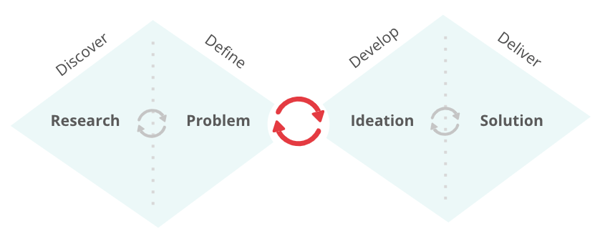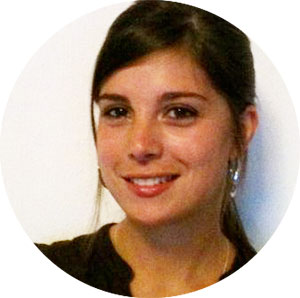September 30, 2020
Ideation workshops: 13 creativity exercises for your focus groups
Do you want to generate new ideas? This article is for you, whether you are looking to stimulate your creativity in a personal setting or in the ideation phase of a professional project, such as a design thinking workshop. We will of course look together at proven ideation methods to stimulate creativity in a group. In addition, we will look at what promotes a creative framework, whether it is an internal creative process or a more participative approach, such as co-design.
When to do an ideation workshop?
It will depend on the design phase you are in. If we are inspired by the double diamond design thinking method, 2 moments can be favorable to ideation.
The first one will be for exploration and discovery, where you want to bring out the needs to identify a maximum of problems.
The second will be for co-creation purposes, where you will need to consider as many solutions as possible for the problem(s) you have identified and retained.
These two moments are phases of divergence during which you must open up the field of opportunities as much as possible, in order to bring out as many ideas as possible. It is the right side of your brain that will be solicited, the one dedicated to imagination.
These two stages are both followed by phases of convergence, where you study and select the ideas that have emerged. The left side of the brain will then play a role, the one that prefers reasoning and analysis.
Who to do ideation workshops with?
With your users of course! But not only with them, you can also conduct workshops with the stakeholders of a project. However, we strongly advise against mixing the two.
In the case of users, we advise you to get closer to your core target for the co-creation stage, but to take a slightly wider target to detect problems in the exploratory phase. This will allow you to identify problems that your prospects encounter, for example, and that prevent them from becoming customers.
In both cases, as with any focus group, we advise you to choose fairly homogeneous profiles within the same group. This will create a synergy and a group dynamic that will allow you to take full advantage of the workshop. To put it simply, people must speak the same language (figuratively speaking), use the same codes, and have the same approach to the subject. We therefore avoid, for example, large age differences, or mixing users of a category with non-users.
The focus group, the ideal framework for your ideation workshops
Focus groups, or consumer workshops, are the most suitable methodology for boosting creativity because they allow you to benefit from a group dynamic.
Before giving you some examples of exercises to offer during these workshops, we would like to remind you of the main rules to follow in order to maximize this dynamic and make the most of your focus group:
Number of people: Ideally, between 5 and 10 people. Beyond that, it becomes complicated for everyone to express themselves easily, and each profile is not used to its fullest potential.
Profile type: In focus groups, it is important to bring together profiles that are fairly similar in order to consolidate your insights, but above all so that the group effect works, and the dynamic can develop. For example, if you bring together businesswomen over 50 years old with male students, it is not certain that there will be a synergy.
Finally, as with any event, the first few moments are crucial. It is therefore important to devote a few minutes to icebreakers, so that participants are in a good state of mind afterwards. This consists of making people talk about an everyday subject, rather easily accessible, like vacations, hobbies, etc.
Icebreakers : exercises to break the ice in the workshop!
Here are three examples:
Name your team
Me, as a superhero
Draw your neighbor
Now that your focus group is in the best possible shape, you can start to address your problem. As seen previously, the ideation workshop format can be adapted for exploratory phases ; understanding users, their behaviors, their perceptions; because being in a group can help to free the word, and for moreadvanced co-desgn phases.
Ideation techniques to explore your users' perceptions and expectations
1. Magic potion or planet
These are projection exercises. Users will be asked to describe what their ideal service or product would look like, similar to a design exercise, or describe it as they see it now.
For magic potion, they will have to list all the ingredients of the corresponding recipe and the corresponding quantities. The fact that the exercise is in the form of a recipe makes it possible to approach the subject in a more casual way and thus remove barriers. The exercise can help prioritize certain elements to be added to an offer, or to identify areas that are too far behind in the brand image.
-
For planet, the exercise is quite similar but is more adapted to concept or brand perception, because it is about describing a universe. In case of a brand perception, we will ask the user to describe what the Apple planet would look like, for example, what the landscapes are like, the population, what language they speak, their jobs, etc.
2. Bono's hats
This method takes its name from the person who developed it, Edward de Bono. The exercise consists of having 6 hats corresponding to different thought patterns:
the white hat for neutrality: it is about exposing figures, facts, everything that will be factual and objective.
the red hat for emotions: on the contrary, here you will let your intuitions and feelings express themselves.
the green hat is that of creativity: you can let out any idea, even the most extreme, without any barrier.
the black hat is that of pessimism: here you list all the obstacles and problems related to the subject.
the yellow hat for optimism: on the other hand, you will list all the positive aspects, opportunities, everything that makes or would make it a success.
and finally, the blue hat for organization: the idea here is to sort out what has been said, to select the most relevant ideas and aspects.
-
enfin, le chapeau bleu pour l’organisation : l’idée va être de faire un peu le tri dans ce qui a été dit, retenir les idées et les points les plus pertinents.
The objective is to make users think in steps according to the hat they are "wearing". There are two options:
The group can reflect together wearing the same hat, and then the hat changes for everyone. In this case, except for the blue hat that usually comes at the end, the order of the others can be changed according to the issue or the group.
Each member may represent a different hat in turn.
The purpose is to challenge one's thoughts, to force oneself to get out of one's usual way of thinking, which is specific to each person. When users wear a different hat, it also has the benefit of creating debate and confronting ideas.
3. The Chinese portrait
Again, this is a typical projection exercise that allows us to ask users their views on a service, a product, a brand, but without asking them directly, which allows them to be more imaginative and to speak more freely.
The objective is, for example, to ask them "if this product was a celebrity, who would it be?" and then repeat the question with, for example, "an animal", "a place", "an era", "a musical style", etc. You can then make the users react on their answers and make them find the common features in a more specific way related to your topic, or do this analysis work yourself after the group.
4. "5 whys
5. Worst idea
Let's conclude this section with an exercise that straddles opinion, ice breaker and co-design. "Worst idea" is a fun and liberating exercise where you invite your participants to choose an idea that is a priori bad, stupid or even illegal and see how to make it a good and legal idea as well it can be practical! The point is to show that all ideas have potential. Depending on the progress of your focus group, this is a good exercise to break the ice, to explore people's relationship to different ideas or to re-start the group dynamic.Ideation exercises to co-create with your users
6. The crazy 8's
The crazy 8's is a very visual exercise that will lead users to draw. Each user will have a sheet of paper with 8 boxes. In each box, the user will have to draw a different solution to answer the same problem. It can be an interface, a single feature, a product, but also the visualization of a service.
Users have a set time to draw their 8 versions of solutions, usually 8 minutes. At the end of this time, everyone submits their sketches, then selects 2 or 3 paths to develop. Again, a time will be set for each person to refine their selected ideas, then all participants will vote for the best solutions among the whole group.
7. Brainwriting
Each participant has a sheet of paper and will have to write down 3 ideas in 5 minutes. He will then pass the paper to his neighbor, who in turn will have to write down 3 ideas, etc. This allows to generate a large number of ideas in a short time.
Another version of this exercise is to develop ideas in a collective way. This time, each user will write down a single idea, then pass the sheet to his neighbor, who will have to develop it by answering for example the question "how". This version generates fewer ideas but allows each user to reflect on the ideas of others and to move forward in a specific way on different possibilities. It can be entirely done following the first method, after selecting the best ideas generated.
3. Moodboard
Photo by Charlota Blunarova on Unsplash
And finally, the moodboard, or collage technique, can be used to express a view, a feeling, as well as formalize expectations about an offer and to imagine what it could look like or correspond to.
The moderator should prepare a large quantity of visuals, between 200 and 300 for a group of 8 people. These visuals should be very different and represent landscapes, characters, or objects. It is also possible to bring in magazines and let the participants choose their visuals from them.
Each user will then have to select between 5 and 10 visuals and, organize them on a sheet of paper in such a way that it illustrates their opinion and feelings about the subject.
This exercise is usually much appreciated by participants who can express their creativity, but also by stakeholders who like the "wow" effect of the visuals.
9. How might we?
10. SCAMPER
- S - Substitute - can we replace a rule, a technology, a team, etc. to improve the situation?
- C - Combine - by joining two distinct elements, what do we obtain?
- A - Adapt - is our current solution adaptable to other situations? More literally, which parts can we adapt to?
- M - Modify, Magnify, Minify - is it possible to modify a characteristic or change perspective: what do you get if you magnify the problem or reduce it (minify)?
- P - Put to other uses - can we change the problem or adapt the solution to another situation where it will be more useful?
- E - Eliminate - is it possible to simplify the problem or the solution? What can we remove from the equation to improve it? Especially useful when removing a problem is more effective than solving it.
- R - Reverse - one can for example invert the priorities but the traudction would be incomplete because it can also be a question of reorganizing the order, for example of the stages in a process or the current priorities.
Workshop techniques for going beyond individual contributions
If you have ever participated in a few brainstorms, you know how certain personalities can over-contribute ideas, at the risk of diminishing the investment of the rest of the group. The following three techniques aim to create this collective energy without focusing on individual ideas.
11. Round Robin or Round Post-Its
- Each participant silently writes down an idea on a post-it. It can also be a problem, a concept, a question...
- Each person then passes his or her post-it note to the person next to him or her, with everyone passing in the same direction and without explaining it. The ideas must therefore be clear and readable enough.
- Everyone will work on the post-it note they have inherited, either by completing the initial idea or by creating a new idea from the first one.
- We repeat these steps of idea passage either a limited number of times, or on a timed basis.
12. The exquisite corpse
- A participant writes "She smiled as she turned to contemplate a life so full."
- The post-it note is folded so that it reads only "a life so full". The next person writes "a life so full that she didn't care much anymore."
- We then get "She smiled as she turned to contemplate a life so full that she no longer cared" and we could continue by passing this last bit to a third participant.
13. Crache ta valda, spit it out
And if we did Lego Serious Play after all that?
These are just a few of the exercises and there are many more examples to choose from depending on your objectives and focus groups. If you would like to learn more about how Ferpection approaches these methodologies, here is our page dedicated to focus groups.
All articles from the category: User research | RSS




